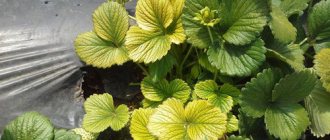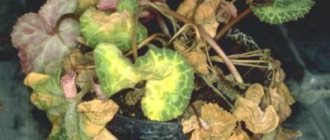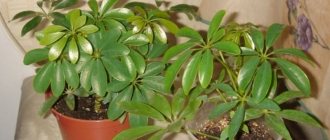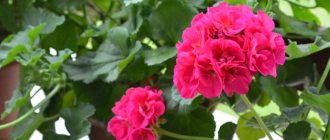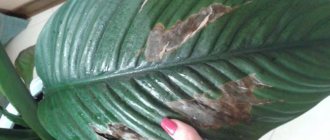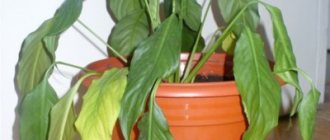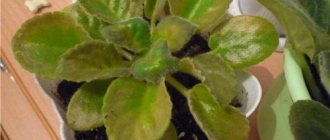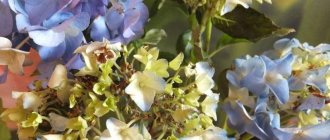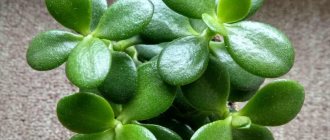- February 7, 2019
- Houseplants
- Marina Star
Why do spathiphyllum leaves and leaf tips turn yellow? Since spathiphyllum is a fairly simple and easy-to-care flower, many gardeners, knowing this, may neglect the basic rules of caring for the plant. To help your green pet, you need to establish exactly why this happened, take the necessary measures to restore the plant in a timely manner, and avoid making mistakes in the future. Why do spathiphyllum leaves turn yellow? What to do? What are the reasons for this? The answers to these questions will be described in this article.
Exhaustion
Spathiphyllum blooms for quite a long time, so this process will require a lot of essential nutrients. If special care is not provided to the plant during flowering, it loses strength, which leads to its depletion.
Signs: yellowing begins from the lower tier of leaves, which spreads quickly and evenly. If assistance is not provided in a timely manner, all leaf blades on the plant will wither.
Feeding and replanting - necessary care for spathiphyllum flowers
Yellowness on the leaves of a recently healthy green bush appears quickly and can be a sign of a variety of problems. Due to the similarity of symptoms, even experienced hobbyists are rarely able to immediately find the reason for this plant behavior. But you cannot hesitate, since the death of the foliage entails a general weakening of the spathiphyllum, and sometimes can signal irreversible putrefactive processes on the roots.
Most often, the source of problems with spathiphyllum is in the care of the flower, or rather, in the lack of attention to the plant.
If the plant has bloomed profusely and for a long time, yellowing leaves may indicate fatigue of the bush, which has wasted all its strength and available nutrients. In this case, the foliage from the lower tiers is the first to begin to experience a similar deficiency, evenly changes color, and then withers.
Feeding can help the plant, and if the yellowed spathiphyllum has not been replanted for a long time, then transferring it to a new, looser pot with nutritious loose soil.
In the future, in order to avoid similar problems, you need to feed the plant twice a year and, if necessary, in the spring, replant the bush into a pot of the same size.
Diseases and pests
If you care for spathiphyllum correctly, it will very rarely get sick. Most often, the plant is affected by a fungus. Spathiphyllum may be exposed to pests or spores from contaminated soil or from a nearby plant.
Signs: all leaves of the plant turn yellow; A white coating appears on the bottom of the leaf blade or insects accumulate, which can become carriers of diseases.
Micronutrient deficiency is the cause of yellowing of spathiphyllum
What to do if the entire spathiphyllum leaves turn yellow? Most often, this symptom can be considered a sign of nutritional deficiency or deficiency of certain elements in the soil. First aid in this case is feeding with complex fertilizer for indoor plants. If the roots of the flower are completely entwined with the earthen ball, then it is better to immediately replant the plant, and, if necessary, divide a large bush.
Spathiphyllum is very sensitive to magnesium deficiency. A deficiency of this element leads to stunted growth and lethargy of the plant. In this case, the spathiphyllum leaves turn yellow in such a way that the veins remain green, and the tissues between them become yellow or brown. Such bushes are fed with magnesium sulfate.
When exhausted
If the cause of yellowing spathiphyllum leaves is exhaustion, it should be replanted immediately. To do this, it is worth preparing a new pot, which will be slightly larger than the previous one. Prepare fresh soil. Remove the plant from the flowerpot and shake off the root system of old soil, keeping the small roots intact. It is also necessary to place a drainage layer in the new pot and add a little new substrate. Place the plant in the pot and straighten the roots. Sprinkle soil on top, but do not bury the growing point. No fertilizing should be done within a month after transplantation. As soon as the yellow leaves that remain on the plant completely wither, it is necessary to remove them, and then begin to fertilize the soil. Half the usual dosage is a good place to start. Gradually, the portions of fertilizing will need to be brought to normal.
It is important to know that if replanting spathiphyllum is complicated by its strong growth, it is necessary to remove the top layer of soil (about 4-5 centimeters thick), and then fill it with new soil and not change the feeding regime.
Help the plant
Women's happiness can be saved if unfavorable factors are eliminated. The plant often needs to be replanted. It is best to do it in the spring. Women's happiness is taken out of the flowerpot and the old soil is removed. Inspect the roots and cut off the affected ones if necessary. If there are children on them, they are seated in separate pots. The neck of the plant is not buried, as it will stop blooming.
Additional Information! If the spathiphyllum has grown and there is nowhere to transplant it in the near future, remove the top ball of soil. The maximum depth is 7 cm. A new substrate is laid out in the free space and fertilizing is given.
The new flowerpot should have drainage holes. Expanded clay is laid on the bottom, and new soil is placed on top of it. When transplanting annual plants, take small pots. If it is too large, the spathiphyllum will not bloom. All forces will go to the growth of the root system. After changing the pot, the plant is not watered, but moistened with a spray bottle. It must get used to the new place.
Low humidity
Leaves that are completely yellowed must be removed. There are several ways to eliminate the problem of dry indoor air:
- cover the batteries with a thick blanket or damp towel;
- Place a container filled with water next to the plant;
- Place a tray with peat, expanded clay or pieces of wet sphagnum on the windowsill; if necessary, add water to the tray;
- regularly spray the air around the spathiphyllum with a spray bottle;
- You can use a humidifier.
The appearance of insect pests
The appearance of a flower can change not only due to poor care, but also due to pest attacks.
Did you know? Spathiphyllum is popularly called
"
women's happiness
"
. According to legend, the Greek goddess of love, Astrada, breathed into this flower a piece of happiness that overwhelmed her on her wedding day, so that every other girl could feel it, believing in the power of the flower.
Thrips
This is a small pest insect with a narrow elongated body and two wings, penetrating the leaf with the help of a tiny proboscis and sucking out all the juices from it. They arise due to lack of moisture, stagnant air, and excess nitrogen in the soil.
Signs of the pest are:
- small brown dots on leaf blades;
- young leaves and flowers become deformed and decrease in size;
- old leaves become covered with spots or a silvery coating and die;
- openwork areas on leaf plates.
You can fight insects using folk or chemical means. But before you start processing the plant, you need to carefully examine it, remove the affected foliage, and burn the diseased flower stalks. Using a cotton swab, collect all the larvae, and wash off the adult insects with a warm shower. Then it is advisable to transplant the flower into new soil and pot, and dispose of the old ones. Now you can carry out treatment with one of the products in case not all pests were destroyed by previous procedures.
Traditional recipes:
- Pour 50 grams of crushed dandelions into a liter of water and leave to steep for 24 hours. Spray the plant with the solution.
- Pour 0.2 kg of chamomile flowers with a liter of boiling water and leave to brew for 10 hours. Strain and spray the flower several times a day for a week.
- 0.1 kg of crushed tobacco should be poured with a liter of boiling water and left for several days. Strain the infusion and treat the entire plant.
Chemicals:
- "Aktellik". 1 ampoule of the product is diluted with a liter of water and used to treat the flower. After the procedure, the spathiphyllum should be covered with a bag for 24 hours.
- "Aktara". 4 g per 5 liters for spraying. Repeat after 7 days.
- "Fitoverm". 2 ml per 200 ml of water for spraying. After the procedure, the flower must be covered with polyethylene for 24 hours.
Find out what to do if spathiphyllum does not bloom.
Mealybug
Small (up to 10 mm in length) multi-legged insects with a round, oval or elongated body covered with a white waxy film. Their head is practically inseparable from their body. They lay white, translucent, round-shaped eggs. Appear due to:
- low temperature;
- increased soil moisture;
- contaminated soil;
- untimely removal of dead parts of the flower.
The parasite usually hides on the inside of the leaf and covers its surface with sticky secretions. If the pest is just discovered, it can be collected with a rag soaked in alcohol.
In case of severe damage, insecticides should be used:
- "Aktara";
- "Biotlin";
- "Calypso";
- "Confidant";
- "Confidor";
- "Mospilan";
- "Tanrek";
- "Fitoverm".
They are diluted according to the instructions indicated on the label, re-processing is carried out after 7-14 days.
Spider mite
Tiny insects, up to 1 mm long, red, yellow, orange. Due to their size, it is difficult to notice; moreover, they settle on the back side of the leaf plate.
A clear sign of their appearance is a thin, small cobweb. Mites attack flowers when the air in the room is too dry and hot.
To prevent the spread of the pest, flowers should be regularly inspected and if a mite is found, wash it off with water and treat it with soapy water. If the case is advanced, then you need to resort to the help of insecticides (Aktara).
Shchitovka
Small oval insects are similar to scale insects. At a young age, it is very difficult to notice them, as they are small and move quickly. Adults are visible as brownish plaques. They usually settle on plants that are overfed with nitrogen, are in a cold or hot room, are not watered correctly, and lack lighting. Their favorite place is the area between the petiole and the stem, as well as the bottom of the leaf blade. You can notice them by dark spots that are actively spreading throughout the flower, and by curled leaves.
When fighting a pest, the affected areas of the spathiphyllum are removed, and the remaining ones are treated with a soap-tobacco solution with the addition of alcohol. Can be treated with nicotine sulfate (1 g per 1 l).
Important! If you use insecticides to control pests, you need to take precautions to avoid getting the product in your eyes or skin.
It is also advisable to carry out the procedure in a non-residential, well-ventilated area. As you can see, neglecting the rules for caring for spathiphyllum can cause a lot of additional trouble. And if the situation gets worse, you may lose the flower altogether. Therefore, it is easier to follow all the rules than to correct the consequences, and besides, they are not so complicated.
When affected by pests or diseases
At the early stage of pest damage to the plant, you should wash the bush with an infusion of wood ash or onion peels. You can also use decoctions of strong-smelling or poisonous plants for spraying: valerian, tansy, celandine and mint.
Decoction recipe:
- cut raw materials;
- place in an enamel bowl;
- pour boiling water;
- place on low heat, do not let it boil;
- remove from heat after twenty minutes;
- cool and strain;
- Pour the broth into a clean glass jar and close tightly with a lid.
Spray the air with the resulting product (no closer than fifty centimeters from the plant). Spathiphyllum must be carefully processed from all sides. This procedure is carried out in the morning and evening for five to seven days.
You can also use a solution of laundry soap and treat the plant with it. But you should know that it is quite difficult to wash a densely grown bush from all sides with this solution. In addition, the product remains powerless against whiteflies.
If there is a large concentration of insects, you can resort to any long-acting systemic insecticides. It is necessary to strictly follow the instructions for use and dosage indicated on the package. If there is such a need, the procedure can be repeated after a week. Not only the green mass should be processed, but also the soil in the pot.
If the plant has been exposed to any disease, then it is very important to take measures to save the spathiphyllum as soon as possible. To do this you need to do the following:
- cut off all affected areas;
- treat the sections with a weak solution of potassium permanganate;
- then sprinkle with activated carbon (crushed);
- thoroughly spray all parts of the plant with any systemic fungicide;
- process the leaves on both sides;
- prepare a new pot and fresh substrate;
- the soil must be disinfected using a strong solution of potassium permanganate, or calcined in the oven;
- treat the pot with Fitosporin;
- transplant the flower into new soil;
- Spray the plant again with the preparation.
In order for a sick flower to recover in the near future, it is recommended to add Epin, aloe juice or Zircon to the water for irrigation. It is worth knowing that if the growing point is damaged by disease or pests, it will not be possible to save the plant.
Natural habitat and growing conditions
To understand how to save spathiphyllum from chlorosis and blackening of foliage, you need to look at the facts:
- where does the flower grow?
- what are the conditions there;
- how the natural habitat differs from those offered to the plant at home.
The tropics are humid forests, but well lit. The temperature there remains approximately the same throughout the year - it is always above 18 degrees. There are slight changes depending on the season. In the winter months it can be colder: up to 10 - 15 degrees.
Spathiphyllum grows in tropical monsoon climates. It is characterized by a uniform distribution of precipitation and slight fluctuations in air temperature - only 4 degrees.
If you imagine the conditions in the middle zone, they will be very different - hot summers and too cold winters. To smooth out such differences, people turn on heating appliances in winter and air conditioners in summer. Any significant fluctuations are detrimental to flowers, so their immunity may not be able to cope with diseases.
Video: Why spathiphyllum leaves turn yellow
Prevention
Basic prevention in cases where spathiphyllum leaves turn yellow:
- Competent care.
- Providing optimal conditions for favorable plant growth.
- As soon as the buds begin to form, it is imperative to increase the dosage of fertilizing. You can use any complex mineral fertilizers that are rich in potassium, boron and phosphorus. The nitrogen content should be low.
An important point is the regulation of the watering regime. You can find out whether soil moisture is necessary in the following ways:
- Pick up the soil in the flowerpot and check the condition of the soil at depth.
- Plant the plant in a transparent pot. If there is no condensation, this is a signal to water.
- Place a stick without bark over the entire depth of the flowerpot and remove it after fifteen minutes. This way the moisture level will be visible.
- Place special beacons in the ground that change color when the humidity changes at a certain height.
To avoid hypothermia of the roots in winter, it is necessary to ensure that there are no drafts. If the room is cool, it is recommended to place a foam plate or a piece of thick woolen fabric under the flowerpot. You can also use a cork hot tray.
Nutrient deficiencies
Spathiphyllum often blooms, causing the soil to become depleted. He also spends energy on shooting the arrow, blooming a flower and maintaining flowering. During this period, the care of the plant needs to be changed, otherwise it will lose leaves and wither. A characteristic sign is yellowing of all shoots at once. Only the veins remain green. This is how iron chlorosis and deficiency of other microelements manifests itself. If measures are not taken, the flower will die.
To replenish reserves, fertilizers with a small percentage of nitrogen are used. Choose fertilizers rich in phosphorus, boron and potassium. They are introduced at the beginning of flowering. They support the plant and prolong this phase.
Note! Nitrogen fertilizing enhances the growth of the green part, which becomes loose and watery. They also suppress flowering.
If fertilizing does not have an effect, the plant is replanted. To do this, take a larger pot. Remove infertile soil from the roots, carefully sorting out the small roots. They tear when handled roughly. The substrate is poured to the same level as in the previous flowerpot.
Important! Immediately after transplantation, the plant is not fed , since the root system needs to take root. Fertilizer is applied after 3–4 weeks.
The tips of the leaves turned yellow
What to do in this situation if the tips of the leaves turn yellow:
- they need to be trimmed, while lightly capturing healthy tissue;
- the reason why this happened should be established;
- you need to carry out all the necessary measures: get rid of harmful factors, care for the plant according to all the rules, ensure optimal conditions for keeping the green pet.
The basic steps will be the same as for complete yellowing of the leaf plate.
What is yellowing?
It happens that indoor flowers change their usual color, usually turning yellow. This phenomenon occurs due to various factors affecting the life processes of the plant. The yellowing parts of the plant do not participate in the process of photosynthesis. As a result, the pigments responsible for the green color are formed in small quantities, and the flower changes color.
Yellow leaves become brittle and crumble easily. Cracks may appear on the sheet plate. Damaged organs lose turgor and strength, and over time the flower loses them.
Follow-up care at home
In order for the plant to please the gardener with its beautiful appearance for a long time, it is necessary to follow the basic rules:
- The lighting should be diffused, there should be no exposure to direct sunlight on the plant;
- the air temperature in spring and summer should be between plus 22 degrees and plus 24;
- in autumn and winter the indicator should not decrease to plus 16 or below;
- in spring and summer, as well as during the period when the plant begins to bloom, it is necessary to water it abundantly;
- In winter and autumn, soil moistening is carried out moderately; excessive moisture and waterlogging of the substrate is not allowed;
- it is necessary to maintain a sufficiently high air humidity in the room and spray the plant often enough;
- in the period from early spring to the end of summer and during flowering, the plant should be fed with a complex of mineral fertilizers with a low concentration.
If the leaves of a spathiphyllum have turned yellow, the reason for this is a gross violation of the plant’s growing conditions. Because of this, it may begin to wither and subsequently die. A very important factor is to establish the cause of this process. Watering should be adjusted, the feeding schedule should be followed, and spathiphyllum should be protected from bright sun and hypothermia.
Spathiphyllum leaves turn black and dry out
Such changes in vegetative organs affected by improper maintenance occur with the same probability as yellowing. But the straw color of the leaves sometimes changes back to green, for example, in the initial stage of chlorosis or with a lack of light. If the plates begin to turn black or dry out, then necrotic changes in the tissue have occurred. It will not be possible to completely restore decorativeness; you can only minimize the consequences.
Incorrect feeding
Often the leaves of the flower of female happiness turn black from excess nitrogen; if nothing is done, the affected areas will begin to rot. If there is an excess of nitrate fertilizers, the leaves of the flower become fatty - they become loose, abnormally large, and dark green in color, uncharacteristic for the variety.
Darkening of the spathiphyllum plates occurs due to a lack of the following nutrients:
- phosphorus - leaves turn brown, blacken and dry along the periphery, starting from the bottom;
- potassium - a deficiency of the element is called a marginal burn, turgor is lost, the plates wrinkle, bend, if nothing is done, they dry out;
- magnesium - first the shade of the tissues becomes violet or purple, then they die.
The tips of the leaves dry out and turn black
Often, necrotic changes first appear at the tips of the plate. The most common reasons:
- Dry air. If there is insufficient humidity in the room, the leaves of aroid crops, including spathiphyllum, dry out and turn black.
- Alternating overdrying with drying out of the soil.
- The flower is sprayed regularly, then stopped.
Why do the leaves around the edges of spathiphyllum turn black and dry?
In addition to phosphorus or potassium deficiency, there may be other reasons for such changes:
- Hypothermia of roots. In this case, the leaves often turn black and dry along the periphery, and turn yellow inside.
- Systematic watering with too hard water. The substrate becomes salty, the roots stop absorbing moisture and fertilizers, and aeration deteriorates.
The leaves turn black, but do not dry out
When overfilled, the plates darken and rot. Excess water in the substrate coupled with cold conditions in winter is especially dangerous - the plant consumes less moisture, and if the earthen ball is not dried immediately, it may die.
When the dormant period passes at a low temperature (close to 16 ° C), spraying the above-ground part of the spathiphyllum is stopped or reduced to a minimum. Overly caring owners may ignore this rule. The leaves darken or turn black, in the worst case, they begin to rot.
Sometimes areas appear on the plant as if sprinkled with coal dust. They can be deployed anywhere. If the marks can be washed off with laundry soap, the cause is sooty fungus.
The disease usually develops on honeydew and rarely appears in an apartment. But in the summer, the leaves of spathiphyllum often turn black outside. The plant is placed under the canopy of large trees - they protect from wind and direct sun, but are ready to “share” their problems.
If a woman's happiness is under a walnut, we can assume that the sooty fungus is guaranteed.
Rules of care
When buying a flower in a store that specializes in selling indoor flowers, it needs to be replanted, and for this you need:
- prepare the soil thoroughly
- the soil mixture should consist of peat, sand, leaf soil and manure humus, taken in equal proportions. The mixture also necessarily contains ceramic chips and crushed birch charcoal.
- The diameter of the pot should exceed the previous one by a couple of centimeters. It must be remembered that the flower needs to be replanted once a year. The pot needs to be enlarged with each transplant.
- the hole intended for removing excess liquid must be covered with a shard with a bulge, and pebbles or expanded clay balls should be poured on top;
To propagate Women's Happiness, the bush can be divided into parts during transplantation. Soaking the earthen ball will help simplify this procedure. The root collar cannot be buried, because the spathiphyllum will stop blooming. The size of the pot should be such that it is a little cramped for the roots. After planting the sprout, compact the substrate and water thoroughly.
If the edges of the leaves dry out slightly, this is not a problem, because the flower needs adaptation.
Women's happiness prefers northern windows, but in winter they can also be placed on the windowsills of southern windows. We must not forget that exposure to direct rays of the sun can cause burns to the flower and cause disease in the root system.
The main condition for maintaining the decorative appearance of the plant is bathing. It loves showers. Its foliage needs to be irrigated with a spray bottle. He really likes to be in the shade, warm, but not stuffy. In summer, the flower will have a comfortable temperature of +22-24 degrees, and in winter – no lower than +17 degrees.
Women's happiness prefers moisture, but its excess can cause rotting of the root system. Experienced gardeners usually wait until the plant itself asks for water: by lowering its leaves. Such a period of drought is not harmful to him. When winter comes, watering is done less frequently, shower procedures are not carried out, only occasionally sprayed.
The plant needs regular feeding.
They need to be carried out when it grows green mass and blooms. Liquid fertilizers are perfect for this; they are diluted in the dose indicated on the package and watered into a pre-moistened soil ball. Fertilizer during the winter period of Women's Happiness does not need to be done as often as in the summer. Just once for the entire period will be enough.
Spathiphyllums are afraid of drafts.
It is necessary to place pots with these flowers away from doors and windows. To increase the duration of flowering, old flower stalks need to be cut off close to the ground. This will make it possible to release new arrows. Simple but mandatory care will extend the flowering period.
